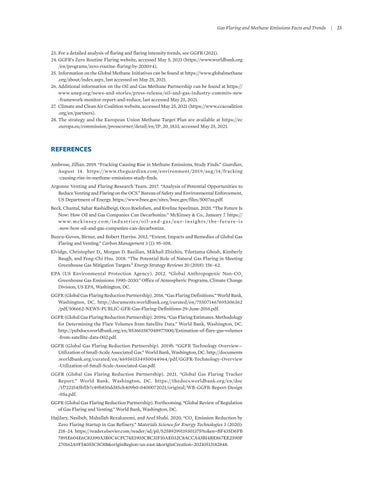Gas Flaring and Methane Emissions Facts and Trends
23. For a detailed analysis of flaring and flaring intensity trends, see GGFR (2021). 24. GGFR’s Zero Routine Flaring website, accessed May 5, 2021 (https://www.worldbank.org /en/programs/zero-routine-flaring-by-2030#4). 25. Information on the Global Methane Initiatives can be found at https://www.globalmethane .org/about/index.aspx, last accessed on May 25, 2021. 26. Additional information on the Oil and Gas Methane Partnership can be found at https:// www.unep.org/news-and-stories/press-release/oil-and-gas-industry-commits-new -framework-monitor-report-and-reduce, last accessed May 25, 2021. 27. Climate and Clean Air Coalition website, accessed May 25, 2021 (https://www.ccacoalition .org/en/partners). 28. The strategy and the European Union Methane Target Plan are available at https://ec .europa.eu/commission/presscorner/detail/en/IP_20_1833, accessed May 25, 2021.
REFERENCES Ambrose, Jillian. 2019. “Fracking Causing Rise in Methane Emissions, Study Finds.” Guardian, August 14. https://www.theguardian.com/environment/2019/aug/14/fracking -causing-rise-in-methane-emissions-study-finds. Argonne Venting and Flaring Research Team. 2017. “Analysis of Potential Opportunities to Reduce Venting and Flaring on the OCS.” Bureau of Safety and Environmental Enforcement, US Department of Energy. https://www.bsee.gov/sites/bsee.gov/files/5007aa.pdf. Beck, Chantal, Sahar Rashidbeigi, Occo Roelofsen, and Eveline Speelman. 2020. “The Future Is Now: How Oil and Gas Companies Can Decarbonize.” McKinsey & Co., January 7. https:// w w w. m c k i n s e y.c o m / i n d u s t r i e s / o i l - a n d - g a s / o u r- i n s i g h t s / t h e - f u t u r e - i s -now-how-oil-and-gas-companies-can-decarbonize. Buzcu-Guven, Birnur, and Robert Harriss. 2012. “Extent, Impacts and Remedies of Global Gas Flaring and Venting.” Carbon Management 3 (1): 95–108. Elvidge, Christopher D., Morgan D. Bazilian, Mikhail Zhizhin, Tilottama Ghosh, Kimberly Baugh, and Feng-Chi Hsu. 2018. “The Potential Role of Natural Gas Flaring in Meeting Greenhouse Gas Mitigation Targets.” Energy Strategy Reviews 20 (2018): 156–62. EPA (US Environmental Protection Agency). 2012. “Global Anthropogenic Non-CO 2 Greenhouse Gas Emissions: 1990–2030.” Office of Atmospheric Programs, Climate Change Division, US EPA, Washington, DC. GGFR (Global Gas Flaring Reduction Partnership). 2016. “Gas Flaring Definitions.” World Bank, Washington, DC. http://documents.worldbank.org/curated/en/755071467695306362 /pdf/106662-NEWS-PUBLIC-GFR-Gas-Flaring-Definitions-29-June-2016.pdf. GGFR (Global Gas Flaring Reduction Partnership). 2019a. “Gas Flaring Estimates. Methodology for Determining the Flare Volumes from Satellite Data.” World Bank, Washington, DC. http://pubdocs.worldbank.org/en/853661587048977000/Estimation-of-flare-gas-volumes -from-satellite-data-002.pdf. GGFR (Global Gas Flaring Reduction Partnership). 2019b. “GGFR Technology Overview— Utilization of Small-Scale Associated Gas.” World Bank, Washington, DC. http://documents .worldbank.org/curated/en/469561534950044964/pdf/GGFR-Technology-Overview -Utilization-of-Small-Scale-Associated-Gas.pdf. GGFR (Global Gas Flaring Reduction Partnership). 2021. “Global Gas Flaring Tracker Report.” World Bank, Washington, DC. https://thedocs.worldbank.org/en/doc /1f7221545bf1b7c89b850dd85cb409b0-0400072021/original/WB-GGFR-Report-Design -05a.pdf. GGFR (Global Gas Flaring Reduction Partnership). Forthcoming. “Global Review of Regulation of Gas Flaring and Venting.” World Bank, Washington, DC. Hajilary, Nasibeh, Mahallah Rezakazemi, and Aref Shahi. 2020. “CO2 Emission Reduction by Zero Flaring Startup in Gas Refinery.” Materials Science for Energy Technologies 3 (2020): 218–24. https://reader.elsevier.com/reader/sd/pii/S2589299119301375?token=BF435D6FB 7891E604E6C83390A3B0C4CFC74E1903CBC31F10AE032C8ACCA43B14BE867EE2590F 270162A9F54055C5C8B&originRegion=us-east-1&originCreation=20210513182848.
|
25


